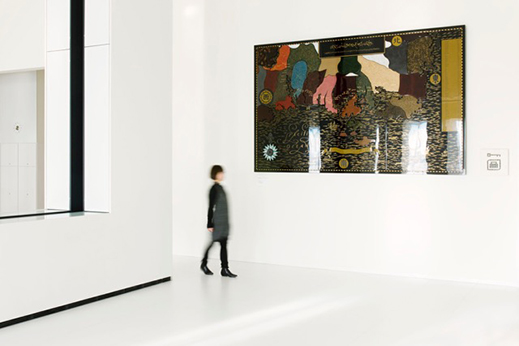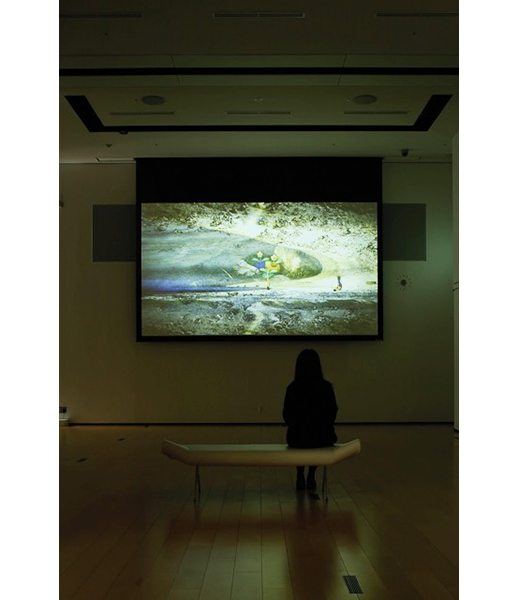 |
|
Here and There introduces art, artists, galleries and museums around Japan that non-Japanese readers and first-time visitors may find of particular interest. The writer claims no art expertise, just a subjective viewpoint acquired over many years' residence in Japan.
|
|
 |
|
|
 |
 |
Shizubi 6: Maverick Machines and Media in Shizuoka
Alan Gleason |
 |
|
The entrance hall of the Shizuoka City Museum of Art. |
Shizuoka has been in the news, and not for the most auspicious of reasons. Headlines recently read that the prefectural capital's population had ignominiously slipped below the 700,000 benchmark required of a "major city" granted special administrative authority by the central government. Fortunately the government responded with assurances that it would not revoke Shizuoka's status, but the city's travails are all too typical of regional centers as they struggle to stem the inexorable flow of people and jobs toward Tokyo.
Located on the Pacific coast 180 kilometers southwest of Tokyo, Shizuoka has plenty of civic pride at stake, not least because of its fine views of nearby Mt. Fuji and its historical cachet as the final residence of Tokugawa Ieyasu, founder of the Edo Shogunate, who retired to Sunpu Castle there. In recent years there has been an ambitious effort to transform the blocks around the central train station (a Shinkansen stop) into a tourist draw. The cornerstone of this renewal is the 25-story Aoi Tower, a gleaming highrise across the street from the station that houses a municipal art museum worthy of wider recognition.
 |
|
A View of the Fifty-Three Stations of the Tokaido (2012) greets visitors in the entrance hall. The 2 x 3-meter lacquer mural shows an aerial view of the Edo-era (1603-1867) Tokaido highway, on which Shizuoka was a major post station. |
The Shizuoka City Museum of Art opened in 2010 with the completion of Aoi Tower, whose entire third floor it occupies. Besides the extensive main gallery, the entrance hall alone is large enough to accommodate a separate exhibition, as it does until 18 June. With six-meter-high ceilings and a bank of windows facing the station plaza, it's a bright, airy, welcoming space.
Shizubi Project 6 (Shizubi being the museum's Japanese acronym) is the sixth iteration of an annual showcase of works by a small selection of contemporary artists. This year's subtitle is Kanata-e, literally "to the far side" -- in this case of art, media, the world, the mind. Filling the entrance hall and an adjacent multipurpose room are works by three artists: Osamu Kokufu, Yuki Hayashi, and Akira Miyanaga.
Kokufu is represented by mechanical devices, Hayashi and Miyanaga by videos. My first impression was that the show, and perhaps the series, was primarily devoted to audiovisual art, with Kokufu's objects a decorative afterthought, but the curator explained that this is actually the first time the Shizubi series has featured digital artists and that the combination of media is coincidental. Though the video works set the tone of the show, they benefit from the levity provided by Kokufu's outlandish constructions.
 |
|
Osamu Kokufu, Sailing Bike (2005), motorcycle parts, sail, FRP. Photo by Keizo Kioku |
Kyoto-born Kokufu (1970-2014) was enamored of vehicles of all sorts, worked for a bicycle maker for a time, and enjoyed building machines that don't really run. He died in a tragic accident while working on one of his installations. On display at Shizubi are Sailing Bike and Propeller Bicycle -- the former a wind-powered motorbike, the latter a bicycle with an engine and propeller attached in back. Both are convincingly constructed of real machine parts and just plausible-looking enough that I had to ask the curator if they actually work. He assured me they do not. A third Kokufu contraption only appears on a video monitor: Natural-Powered Vehicle, consisting of a standard automobile with a mast and sail attached to its roof. Though the vehicle sits on a jetty facing the sea and into the wind, one assumes the artist did not attempt to sail it.
|
Osamu Kokufu, Propeller Bicycle (1994), bicycle parts, steel, wood, engine. Photo by Keizo Kioku |
Kokufu's intention was, rather, to "create vehicles that run on imagination." He was also motivated by ecological concerns -- one 2012 installation had an internal combustion engine suspended and running in a tank of water, evoking the recently melted down nuclear reactors of Fukushima. The sparse selection at Shizubi does not really do justice to his oeuvre, and merely whets the appetite for a larger retrospective. More of Kokufu would also add some balance to the otherwise videocentric tilt of the show.
Hayashi and Miyanaga share some similarities: both artists display their work on screens and monitors, are adept at layering disparate images to sometimes sublime effect, and employ a broad palette of techniques to this end. But their preoccupations differ.
|
Yuki Hayashi, another world 002 (2014), Internet system, Google, YouTube, FHD video (multichannel), personal computer, digital terminal. |
Hayashi (1976-) was also born in Kyoto. His media of choice are laptops, iPads and iPhones; several such devices are scattered around a niche of the multipurpose room on tables or the floor as part of his installation another world 002, in which a myriad of tiny icon-like images randomly extracted from the Internet swim across the screens over still shots of equally random land- and city-scapes. Symbolic, no doubt, of the blizzard of information that threatens to obscure our view of the world today, but the visual impact is diffused by the plethora of electronics.
|
Yuki Hayashi, IMAGE DATA (2016), FHD video, at left. Two works by Akira Miyanaga are visible at right rear. Photo by Keizo Kioku |
More demonstrative of Hayashi's creative imagination are two other works. A big high-definition screen dangling obliquely at eye level displays the entrancing IMAGE DATA, in which large placard-like pixels flip over in serial cascades of beautiful, ever-shifting abstraction. The piece is mesmerizing. Elsewhere, on a very small monitor in an alcove by itself, the outline of everything shows a man's hands magically transforming a black threadlike line on a white table into a parade of unlikely shapes. The line morphs into two dimensions, then three, becoming a vase, a tree, a road sign, a row of houses, a plastic hippopotamus, and on and on. It's a puckish meditation on the breakdown of the boundary between data and matter in the age of the 3D printer. Both of these productions are capable of holding visitors in thrall for multiple viewings.
|
Yuki Hayashi, the outline of everything (2010), video, monitor. Photo by Keizo Kioku |
Born in Hokkaido but now Kyoto-based, Miyanaga (1985-) describes himself as "searching for something non-temporal in a traditionally time-based art." This he achieves through a process of layering video images that build up into a kind of static climax. The two Miyanaga works at Shizubi succeed in this respect with dramatically different visual material. In about the lights of land a row of seven small monitors shows various sequences of footage, shot from a car window, of a construction site on a city street at night. A larger monitor exhibits the result of overlapping and altering the speed of these sequences to generate an increasingly frenzied, cacophonous collage of light and sound.
|
Akira Miyanaga, about the lights of land (2010), FHD video (8-channel). Photo by Keizo Kioku |
The tour de force of this entire show, however, is KIWA (which might be translated as "extreme" or "edge"), a video on a theater-size screen in the darkened multipurpose room that projects a surreal landscape -- a desert lake and mountains, it seems -- in which human figures appear and disappear, along with the occasional pop-up plastic flowers. The bizarre colors and juxtapositions of objects challenge the mind's vain attempt to make sense of the imagery, which seduces us with its flirtation between the familiar and the inconceivable.
Other than the artists' shared Kyoto connection, it was hard to pin down a unifying context to Shizubi Project 6, but in the end that didn't matter. Somehow or other, the exhibits fit together in a gratifying smorgasbord of visual and philosophical stimuli. If their only element in common is the venue itself, one must credit the museum's architect for a liberating layout that grants these diverse works ample space even as it embraces and connects them.
From 4 June the exhibition will expand into Shizubi's main gallery rooms, adding new works by Hayashi and Miyanaga. The two artists will collaborate with guest musicians in a multimedia event at the museum on 17 June at 4 p.m.
 |
|
Akira Miyanaga, KIWA (2013), FHD video (9 minutes). Photo by Keizo Kioku |
All images courtesy of the Shizuoka City Museum of Art.
|
 |
| Shizubi Project 6 |
| 28 March - 18 June 2017 |
| Shizuoka City Museum of Art |
Aoi Tower 3F, 17-1 Koyamachi, Aoi-ku, Shizuoka City
Phone: 054-273-1515
Open Tuesday to Sunday 10 a.m. to 7 p.m. (entry until 30 minutes before closing)
Closed Mondays (or the following day when Monday is a national holiday), and year-end/new-year holidays
Access: 1-minute walk from the north exit of JR Shizuoka Station; 1 hour by Tokaido Shinkansen from Tokyo |
|
|
|
| |
 |
Alan Gleason
Alan Gleason is a translator, editor and writer based in Tokyo, where he has lived for 30 years. In addition to writing about the Japanese art scene he has edited and translated works on Japanese theater (from kabuki to the avant-garde) and music (both traditional and contemporary). |
|
|
|
|
|
|
|
|
|
 |
|